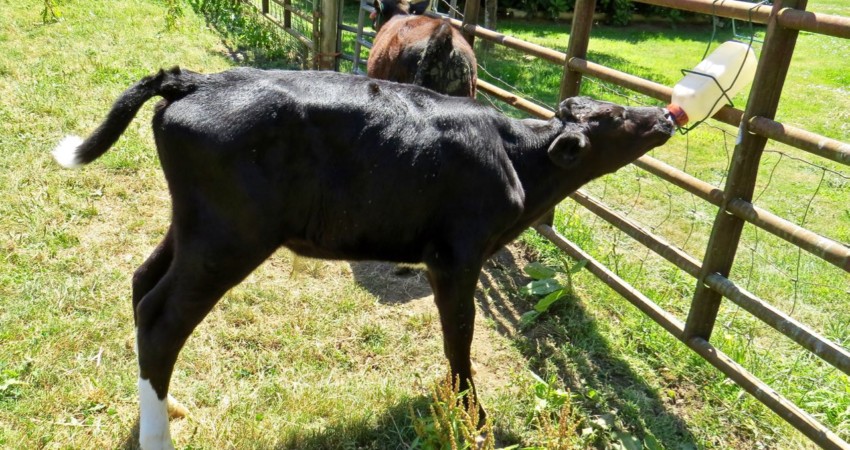

Raising bottle calves can be a good way of starting your herd. However, there is also an element of risk to it because young calves are very vulnerable to illness.
Where to get your calves
Sometimes you will have no choice about raising a bottle calf if the mother died giving birth. The calf may be stressed from a traumatic birth, so you must keep it warm and dry. Getting calves from a neighboring farm or dairy is another good way of finding bottle calves. Ask the owner if the calves have had colostrum, and only buy calves that are alert with bright eyes and have clean bottoms with normal poop. Be careful when buying bottle calves from an auction. You will have no way of knowing what bacteria the calf has been exposed to, nor will you have the assurance that the calf has had colostrum.
Preparing a Feeding
Calves need about a gallon of milk a day, split into two feedings. You can use milk replacer, in which case you should mix it with warm water according to the instructions on the bag. Make sure that his bottle is warm. Never feed a calf cold milk. It could kill him. Buy the highest quality milk replacer that you can afford
The best feeding for a calf is another lactating cow’s milk. If you have access to fresh, raw milk, your calf will probably do better than on milk powder. If the milk is cold, warm it up to body temperature. Don’t microwave your raw milk; it will kill some of the natural enzymes that will help the calf digest the milk.
The First Feeding
The first few feedings may be little more than a wrestling match between you and the calf. Most calves resent the hard rubber nipple of a nursing bottle and will fight you. Put the calf in a small pen or a horse stall, so he can’t get away from you. Back the calf into a corner with his bottom in the corner against the wall.
Straddle the calf around the shoulders, and gently pin his head in one place with your knees. Then, you will have to pry open the calf’s mouth and stick the nipple in there. The calf will probably try to back away from you. You may need to reach into the sides of the calf’s mouth and squeeze the nipple to give him a taste of milk. Sometimes most of the first feeding will be from you squeezing the nipple and it trickling down his throat. Eventually, at some point during that first feeding he will get the hang of sucking the nipple, even if it is just a few sucks.
Hold the bottle very low. If the calf has to reach very far up to take the milk, he could end up with milk in his lungs, leading to pneumonia.
The first three days are going to be the hardest. But after that point, he will learn that you are his mama, and he will look forward to your visits to the barn. You will be able to hold the bottle through the fence for him. The calf will become a greedy little pig and act like he’s starving when he’s sucked down his bottle. Don’t believe him, because if you feed him too much at one time, it will upset his stomach and he’ll get scours. (calf diarrhea)
Other Feed
Your calf should always have access to a source of fresh water in his pen. Make sure that the tub is low enough for him to reach, but tall enough that he can’t fall into it. Also, make sure that he can’t tip it over.
When he’s about a week old, put out a little fresh, high-quality hay for him to nibble on. He won’t eat much, but after a few weeks, he will begin to eat more of it.
At two weeks of age, you can start to offer a calf starter grain ration. The best time to do this is right after he’s taken his bottle. When he’s still looking for more to eat, grab a handful of grain and stick it in his mouth. Most of it will drop out of his mouth, but soon he will eat it happily.
Give him access to a salt block so that he can get any minerals his diet may be deficient in.
Weaning
When the calf is about five months old, you can cut back to one bottle of milk per day. By this time, most of his food should be from hay or grass. He will still run to the fence and bawl at you when he sees you, hoping for a hand out.
At six months, your calf is ready to be weaned. Simply stop giving him his daily bottle. Now is the time to make sure that your calf is vaccinated. Most of our bottle calf losses have been when we’ve put off vaccinating at weaning time.
Raising a bottle calf is a great project for kids, and if all goes well, it only takes a few minutes every morning and afternoon for feedings. Take a few minutes every day to simply watch the calf. By checking him over every day, you will be able to quickly address any health problems before they become big ones. The key to having healthy bottle calves is to be proactive and treat any illnesses as soon as you notice something is amiss.
 Contact Jaguza Support
Contact Jaguza Support